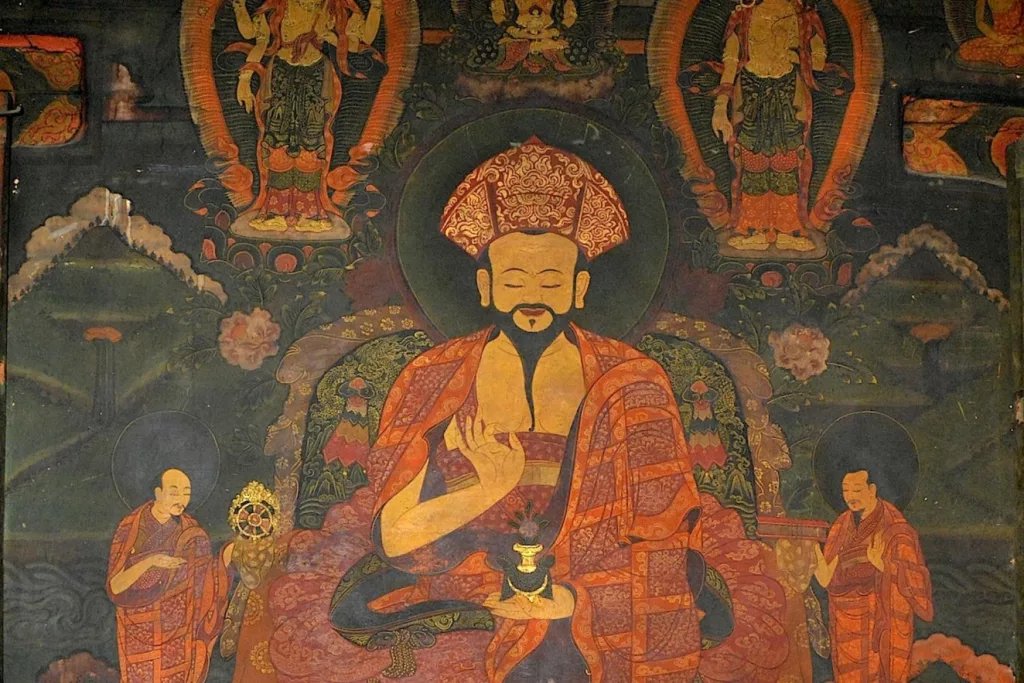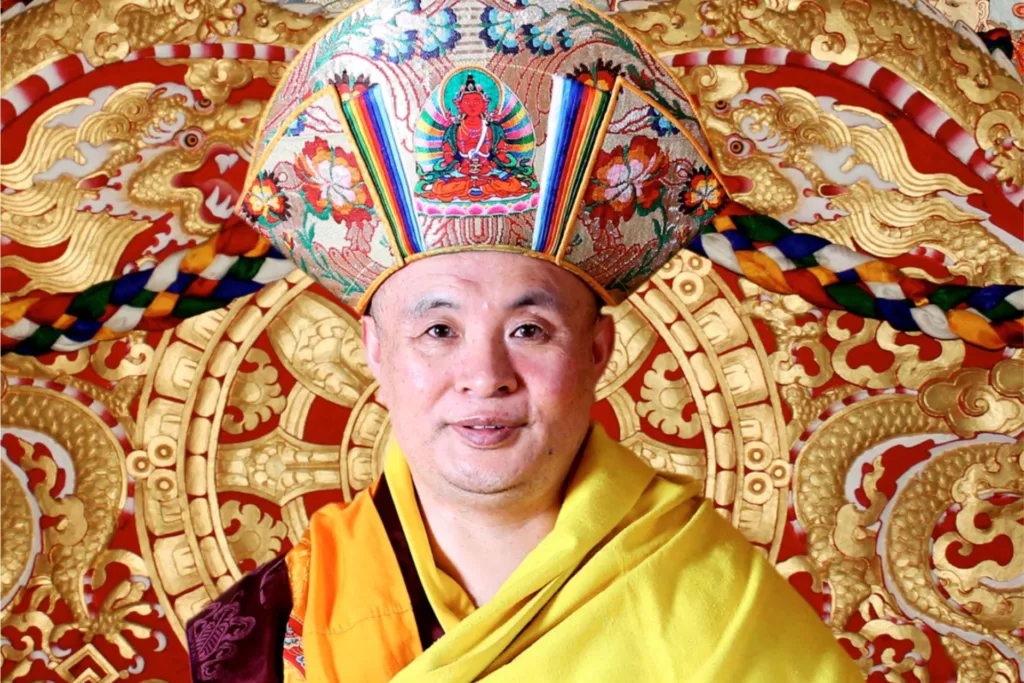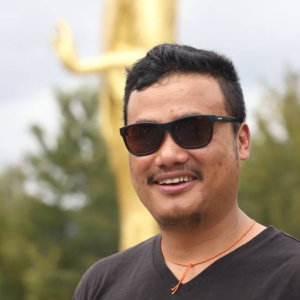Zhabdrung Kuchoe is an important national holiday in Bhutan, observed annually in remembrance of the death anniversary of the great leader Zhabdrung Ngawang Namgyal. It takes place on the 10th day of the 3rd month of the Bhutanese calendar. On this day, government offices and schools across the country remain closed to pay respect to Zhabdrung Ngawang Namgyal.
The central monastic body conducts special prayer ceremonies, such as reciting Zhabdrung’s zhabten (prayer for stability of life), and offers thousands of butter lamps in dzongs and monasteries throughout Bhutan. In Thimphu, residents visit Lhakhangs and Goendeys, including the Memorial Chorten and Changangkha Lhakhang.
Zhabdrung Ngawang Namgyal entered meditation at the age of 58 for 12 years at Pungthang Dewai Chenpoi Phodrang in 1651. However, his death was only formally announced in 1701, half a century later. This delay aimed to preserve the newly established unity among the Bhutanese people under his leadership, as Zhabdrung Ngawang Namgyal had united Bhutan for the first time. Until the announcement of his death, it was believed that he was still meditating.
འཇིག་རྟེན་དབང་ཕྱུག་ཐུགས་རྗེའི་རླབས་འཕྲེང་དབུས། །
jikten wangchuk tukjé lab treng üAmidst the waves of the Lord of the World’s compassion,
རྒྱལ་ཀུན་མཁྱེན་བརྩེའི་འདབ་སྟོང་རྒྱས་པ་ལ། །
gyal künkhyen tsé dab tong gyepa la
Blossoms a thousand-petalled lotus of all the buddhas’ wisdom and love,
ཕན་བདེའི་དྲི་བསུང་ཅི་ཡང་སྤྲོ་བའི་གཉེན། །
pendé drisung chiyang trowé nyen
Radiating the sweet fragrance of benefit and happiness—
ངག་དབང་རྣམ་རྒྱལ་ཞབས་ལ་གསོལ་བ་འདེབས། །
ngawang namgyal zhab la solwa deb
Ngawang Namgyal, at your feet I pray.
མཁྱེན་པས་མ་རིག་མུན་པའི་ཚོགས་འཇོམས་ཤིང༌། །
khyenpé marik münpé tsok jom shing
In your wisdom, you conquer the darkness of ignorance;
བརྩེས་བས་གཞན་དོན་ཡལ་བར་མི་འདོར་བར། །
tsewé zhendön yalwar mi dorwar
In your love, you never forsake the welfare of others;
ནུས་པས་བདུད་དཔུང་འཇོམས་བྱེད་ལྷ་ཡི་ལྷ། །
nüpé düpung jom jé lha yi lha
In your power, you overcome the forces of Māra—
ངག་དབང་རྣམ་རྒྱལ་ཞབས་ལ་གསོལ་བ་འདེབས། །
ngawang namgyal zhab la solwa deb
Supremely divine Ngawang Namgyal, at your feet I pray.
ཁམས་གསུམ་སེམས་ཅན་འཁོར་བ་ལས་སྒྲོལ་ཕྱིར། །
kham sum semchen khorwa lé drol chir
To liberate sentient beings from the three realms of saṃsāra,
འཆི་མེད་རྡོ་རྗེའི་སྐུ་མཆོག་རབ་བརྙེས་ནས། །
chimé dorjé ku chok rab nyé né
Having perfectly attained the supreme, immortal vajra-kāya,
འཕྲིན་ལས་རྣམ་བཞིས་འགྲོ་བའི་དོན་མཛད་པའི། །
trinlé nam zhi drowé dön dzepé
May you bring benefit through the four kinds of activity
ཇི་སྲིད་འཚོ་ཞིང་གཞེས་པར་གྱུར་ཅིག་གུ། །
jisi tso zhing zhepar gyur chik gu
And remain forever, as long as existence itself endures.

Journey from Tibet to Unifying Bhutan
Zhabdrung Ngawang Namgyel was born in 1594 to Yab Tenpai Nyima, a Drukpa Kagyu religious leader, and Yum Sonam Pelkyi Butri in central Tibet, among a well-known religious aristocracy. His grandfather, Mipham Choegyal, was exiled from Tibet by rivals. Mipham Choegyal was the seventeenth abbot of the Drukpa Kagyu School in Ralung. Zhabdrung received plenty of religious training from his grandfather to become the eighteenth abbot of Ralung School.
In 1606, when Zhabdrung was only 12, his grandfather passed away. As a result, he became the 18th abbot of Ralung monastery in Tibet. Ralung was the traditional stronghold of the Drukpa Kagyu order, and Zhabdrung spent a lot of his time on religious studies and developing artistic skills in traditional painting and sculpting. He was recognized as the reincarnation of the respected Drukpa Kagyu scholar Kunkhyen Pema Karpo (1527-1592), who was believed to be the incarnation of Tsangpa Gyare Yeshe Dorje (1161-1211), the founder of the Drukpa Kagyupa.
Another person, Pagsam Wangpo, also claimed to be the true reincarnation of Kunkhyen Pema Karpo. Tsang Desi Tensung Wangpo supported Pagsam Wangpo’s claim, while new Tsang Desi Phuntsho Namgyal opposed Ngawang Namgyel and backed Pagsam Wangpo. Phuntsho Namgyal took his father’s place after giving up the throne. Amid the chaos and to ensure the safety and peace of his people in Tibet, Zhabdrung Ngawang Namgyel left Tibet forever.

Following a prophecy by Bhutan’s protecting deity in a dream, Zhabdrung Ngawang Namgyel decided to travel to Bhutan. Many high Drukpa Kagyu lamas also invited him to Bhutan. In 1616, at 22 years old, Zhabdrung Ngawang Namgyel left Tibet and went to Bhutan. He was welcomed by Hobtsho Lam, who had close family and religious connections with the Gya family, and the people of Laya and Gasa.
Upon arriving in Bhutan, Zhabdrung Ngawang Namgyel brought with him the sacred relic, Rangjung Kharsapani (a self-created statue of Chenrezig, which appeared from the vertebrae of Tsangpa Gyarey Yeshi Dorji during his cremation). The Punathang Dewa Chenpoi Phodrang houses the Rangjung Kharsapani. He rested in Laya before continuing to Gasa, where the people of Laya and Gasa showed their respect and promised their loyalty.
He was welcomed by the people of northern Bhutan and then traveled to the upper Thimphu valley via Karbi to Pangri Zampa. There, he visited a temple built by his great-great-grandfather, who had once traveled to Bhutan. He also went to the Dechenphug temple, the home of the Protective guardian deities of the Drukpas since the 14th century. Zhabdrung paid respect to the deities in the temple before traveling to the Paro valley via Jela Dzong and finally to Druk Choeding Lhakhang in the center of the Paro valley.

Zhabdrung's Quest for Unity & Defending Bhutan Against Invaders
Upon his arrival in Bhutan and establishment of residency in Druk Choeding Lhakhang of Paro valley, Zhabdrung immediately embarked on a mission to unify the country. This was met with opposition in the form of a Tibetan invasion led by Tsang Desi, triggered by Zhabdrung’s acquisition of the sacred relic Rangjung Kharsapani. The Bhutanese, however, were successful in repelling the invading forces and eliminating the invading general.
Subsequently, Zhabdrung journeyed to Tango monastery in upper Thimphu where he was warmly received by Tshewang Tenzin, grandson of Drukpa Kuenley. He meditated, recited prayers, and wrote the poem Ngachu druma (Sixteen I’s), which he used to establish a seal.
News of a stronger force being assembled by Tsang Desi to assassinate Zhabdrung reached him, but was soon followed by reports of the Desi’s death in Tibet along with his wife. Zhabdrung then visited Chapcha before returning to Tango, where he learned of the passing of his father, Tenpai Nyima, in Ralung. He dispatched a trusted entourage to retrieve his father’s remains and brought them to Bhutan.
In 1620, Zhabdrung established Chari Monastery and established the first monk body. He made the monastery his permanent residence and invited scholars and teachers from Ralung to teach there. After completing his work, Zhabdrung retreated for three years.

Even with the defeat of Tsang Desi’s forces and establishment of the monastery, Zhabdrung’s troubles were far from over. He faced opposition from within the country from a group called Lam Kha Nga, consisting of Lhakpas, Nyingmapas, Barawas, Kathogpas, and Chazampas. The first attack occurred in 1629 when Zhabdrung was occupied with building Simtokha Dzong. The attacking leader was assassinated, but the opposition was not fully quelled.
Following a series of incursions, Lam Kha Nga sought the assistance of Tsang Desi’s son to eliminate Zhabdrung. In 1634, the Tibetans once again launched an attack in various locations, but they were ultimately defeated. In 1639, they again invaded Bhutan at the invitation of Lam Kha Nga, with the aim of defeating or assassinating Zhabdrung. However, this endeavour proved fruitless and resulted in a concurrence between Tsang Desi and Zhabdrung, wherein Desi acknowledged Zhabdrung’s rule over Bhutan.
In Tibet, the Tsang Desi lost their influence and the Gelugpas, led by successive Dalai Lamas who served as both temporal and spiritual leaders, took control of the country. The Gelugpas, in conjunction with Mongol forces, attacked Bhutan in 1644 but were repelled and defeated. Four years later, Bhutan faced consecutive invasions in 1648 and 1649 and once again emerged victorious. Despite several more attempts by the Tibetans from various directions, including Thimphu, Paro, and Punakha, the Bhutanese, under the leadership of Zhabdrung Ngawang Namgyel, successfully defended themselves each time.

Unifying Bhutan Through Dzong Construction & Religious Reformation
Zhabdrung, a historical figure in Bhutan, not only faced various stages of invasions but also constructed numerous dzongs (fortresses) throughout the country. In 1629, he built Simtokha Dzong at the entrance of Thimphu valley, which still stands beautifully on a hill. This was the first dzong built by Zhabdrung in Bhutan and served as a means of controlling traffic between the powerful Paro valley to the west and Trongsa valley in central Bhutan.
In 1637, Zhabdrung began constructing Punakha Dzong, followed by Wangduephodrang Dzong in 1638. He also seized the old Lhakpa dzong of Thimphu, where Dechenphodrang stands today. Prior to Zhabdrung’s arrival in Bhutan, the Lhakpa sect of religion was popular in the country. Zhabdrung abolished the Lhapa sect of Thimphu and established the Drukpa Kagyu sect of religion. In 1645, the old Drukpa family of Hungrel in Paro presented their small dzong to Zhabdrung, who replaced it with a larger one and renamed it Rinpung Dzong.

The Nyingmapa sect of religion offered Zhabdrung the monastery of Taktshang. He then built Drukgyel Dzong to guard the Paro valley against future Tibetan invasions. The dzong was also said to be built in celebration of the victory over a Tibetan invasion.
Although Zhabdrung did not move to eastern Bhutan, his power and influence extended to Trongsa, where he built Trongsa Dzong and named it Druk Choekhor Rabtse Dzong. In 1651, he built Daga Tashi Yangtse Dzong in Dagana. With the construction of these dzongs, he almost covered the entire country. He also divided it into three regions, each ruled by a Poenlop, the eastern, western, and central regions.

Unifying Bhutan & Establishing the Choe-Si System
The legendary Zhabdrung Ngawang Namgyal, after constructing the Daga Tashi Yangtse Dzong in Dagana, succeeded in bringing the entirety of Bhutan under his rule, dividing the nation into three distinct regions. The Poenlops were delegated to govern each of these territories, with the Daga Poenlops assigned to the South-Central region, the Paro Poenlops responsible for the West and South-West, and the Trongsa Poenlops overseeing the East and South-East.
Zhabdrung appointed the Je Khenpo as the head of the country’s spiritual affairs and the Desi as its political leader, thus instituting the revered Choe-Si system with dual leadership. Zhabdrung himself assumed the mantle of supreme authority in both religious and political matters.
Not only did he unify Bhutan, but Zhabdrung also secured its independence, withstanding numerous Tibetan invasions and internal threats. He established the Drukpa Kagyu as the official state religion and devised the systems of administration and religion that still endure today.
During his 35-year tenure, Zhabdrung implemented practices and systems that were not commonplace in Tibet, and assumed the title of Zhabdrung – “at whose feet one submits.” He is revered as the Zhabdrung Rinpoche, the precious Jewel at whose feet one submits, and remains the greatest figure in the history of Bhutan’s religious and political systems.

Honoring Zhabdrung Rinpoche's Memory through Sacred Traditions
The Zhabdrung Rinpoche was not only a sovereign leader, but also dedicated a significant portion of his reign to constructing Dzongs throughout the land. Upon his passing in 1651 at Punakha Dzong, his closest confidants kept the news of his death under wraps for fifty years to prevent political turmoil and future foreign incursions. During this time, it was said that he continued to govern the kingdom from behind the scenes, although this explanation becomes increasingly implausible given the extended silent retreats he was known to take during his life.
The Zhabdrung Rinpoche’s mortal remains rest within a sanctified niche within Punakha Dzong, currently known as Machen Lhakhang, where they have been guarded continuously since his death in the seventeenth century. This responsibility falls to two prominent lamas and is considered one of the most sacred obligations in the kingdom. Not even the Penlops and other high-ranking officials were granted access to the inner sanctum. Today, entry is limited to the King, Je Khenpo, and Machen Zimpoen. The sacred five-colored scarf for the King and during the King’s wedding is always retrieved from this sacred site.

The revelation of Zhabdrung Ngawang Namgyal’s passing was not made public until half a century after the event, with confabulation circulating that he was still in deep meditation. Since then, the annual commemoration of Zhabdrung Kuchoe has taken place on the 10th day of the third Bhutanese Calendar.
Every year, thousands of devout followers gather to receive blessings and offer prayers to the Rangjung Kharsapani, displayed by the Central Monastic Body for all to see. This day is celebrated throughout the entire country as a tribute to the great leader who worked tirelessly to unify and establish the Choe-Si systems and other lasting legacies within Bhutan. To honor his memory, people visit monasteries, chortens, religious sites, and other sacred places to offer prayers and light butter lamps in his name.
We the Bhutanese either Buddhists ,Hindus or Christians must pay This Great man a homage as a man who unified Bhutan since we are first BHUTANESE.

FAQs on Zhabdrung Ngawang Namgyel
Zhabdrung Kuchoe is an important national holiday in Bhutan, observed annually in remembrance of the death anniversary of the great leader Zhabdrung Ngawang Namgyal. It takes place on the 10th day of the 3rd month of the Bhutanese calendar.
Zhabdrung Ngawang Namgyal was a great leader who united Bhutan for the first time, established the Choe-Si system with dual leadership, and secured the country’s independence by withstanding numerous Tibetan invasions and internal threats. He also established the Drukpa Kagyu as the official state religion and devised the systems of administration and religion that still endure today.
Zhabdrung Ngawang Namgyal constructed numerous dzongs (fortresses) throughout the country, including Simtokha Dzong, Punakha Dzong, Wangduephodrang Dzong, Rinpung Dzong, Drukgyel Dzong, Trongsa Dzong, and Daga Tashi Yangtse Dzong. These dzongs played a crucial role in unifying Bhutan and protecting it from invasions.
On Zhabdrung Kuchoe, the central monastic body conducts special prayer ceremonies, such as reciting Zhabdrung’s zhabten (prayer for stability of life), and offers thousands of butter lamps in dzongs and monasteries throughout Bhutan. People also visit monasteries, chortens, religious sites, and other sacred places to offer prayers and light butter lamps in his name.
The news of Zhabdrung Ngawang Namgyal’s death was concealed for fifty years to prevent political turmoil and future foreign incursions. This delay aimed to preserve the newly established unity among the Bhutanese people under his leadership. Until the announcement of his death, it was believed that he was still meditating.
His death was kept a secret to preserve the newly established unity among the Bhutanese people under his leadership and to prevent political turmoil and foreign incursions. It was believed that he was still meditating during that time.
The Rangjung Kharsapani is a self-created statue of Chenrezig, which appeared from the vertebrae of Tsangpa Gyarey Yeshi Dorji during his cremation. It is considered a sacred relic and is displayed by the Central Monastic Body during Zhabdrung Kuchoe for people to receive blessings.
Zhabdrung appointed the Je Khenpo as the head of the country’s spiritual affairs and the Desi as its political leader, thus instituting the revered Choe-Si system with dual leadership. He himself assumed the mantle of supreme authority in both religious and political matters.
Dzong construction played a vital role in the unification of Bhutan by establishing a strong presence and administrative control throughout the country. These fortresses were also used as defensive structures against foreign invasions and internal opposition.
To honor his memory, people visit monasteries, chortens, religious sites, and other sacred places to offer prayers and light butter lamps in his name. The Central Monastic Body also conducts special prayer ceremonies and displays the sacred Rangjung Kharsapani for people to receive blessings.

